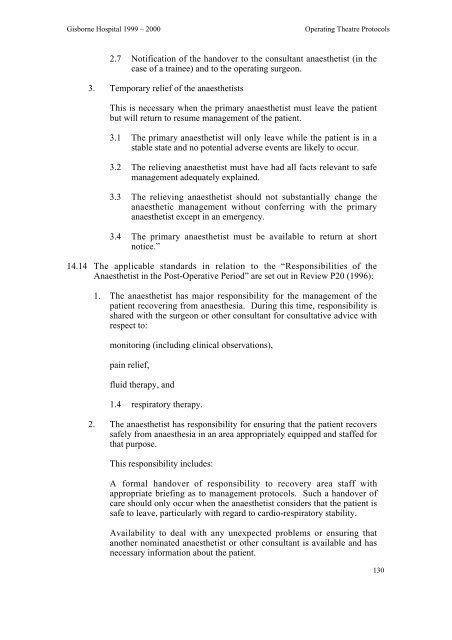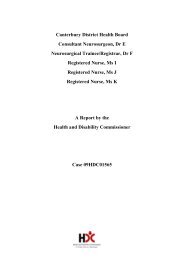Gisborne Hospital Report - Health and Disability Commissioner
Gisborne Hospital Report - Health and Disability Commissioner
Gisborne Hospital Report - Health and Disability Commissioner
Create successful ePaper yourself
Turn your PDF publications into a flip-book with our unique Google optimized e-Paper software.
<strong>Gisborne</strong> <strong>Hospital</strong> 1999 – 2000<br />
Operating Theatre Protocols<br />
2.7 Notification of the h<strong>and</strong>over to the consultant anaesthetist (in the<br />
case of a trainee) <strong>and</strong> to the operating surgeon.<br />
3. Temporary relief of the anaesthetists<br />
This is necessary when the primary anaesthetist must leave the patient<br />
but will return to resume management of the patient.<br />
3.1 The primary anaesthetist will only leave while the patient is in a<br />
stable state <strong>and</strong> no potential adverse events are likely to occur.<br />
3.2 The relieving anaesthetist must have had all facts relevant to safe<br />
management adequately explained.<br />
3.3 The relieving anaesthetist should not substantially change the<br />
anaesthetic management without conferring with the primary<br />
anaesthetist except in an emergency.<br />
3.4 The primary anaesthetist must be available to return at short<br />
notice.”<br />
14.14 The applicable st<strong>and</strong>ards in relation to the “Responsibilities of the<br />
Anaesthetist in the Post-Operative Period” are set out in Review P20 (1996):<br />
1. The anaesthetist has major responsibility for the management of the<br />
patient recovering from anaesthesia. During this time, responsibility is<br />
shared with the surgeon or other consultant for consultative advice with<br />
respect to:<br />
monitoring (including clinical observations),<br />
pain relief,<br />
fluid therapy, <strong>and</strong><br />
1.4 respiratory therapy.<br />
2. The anaesthetist has responsibility for ensuring that the patient recovers<br />
safely from anaesthesia in an area appropriately equipped <strong>and</strong> staffed for<br />
that purpose.<br />
This responsibility includes:<br />
A formal h<strong>and</strong>over of responsibility to recovery area staff with<br />
appropriate briefing as to management protocols. Such a h<strong>and</strong>over of<br />
care should only occur when the anaesthetist considers that the patient is<br />
safe to leave, particularly with regard to cardio-respiratory stability.<br />
Availability to deal with any unexpected problems or ensuring that<br />
another nominated anaesthetist or other consultant is available <strong>and</strong> has<br />
necessary information about the patient.<br />
130
















